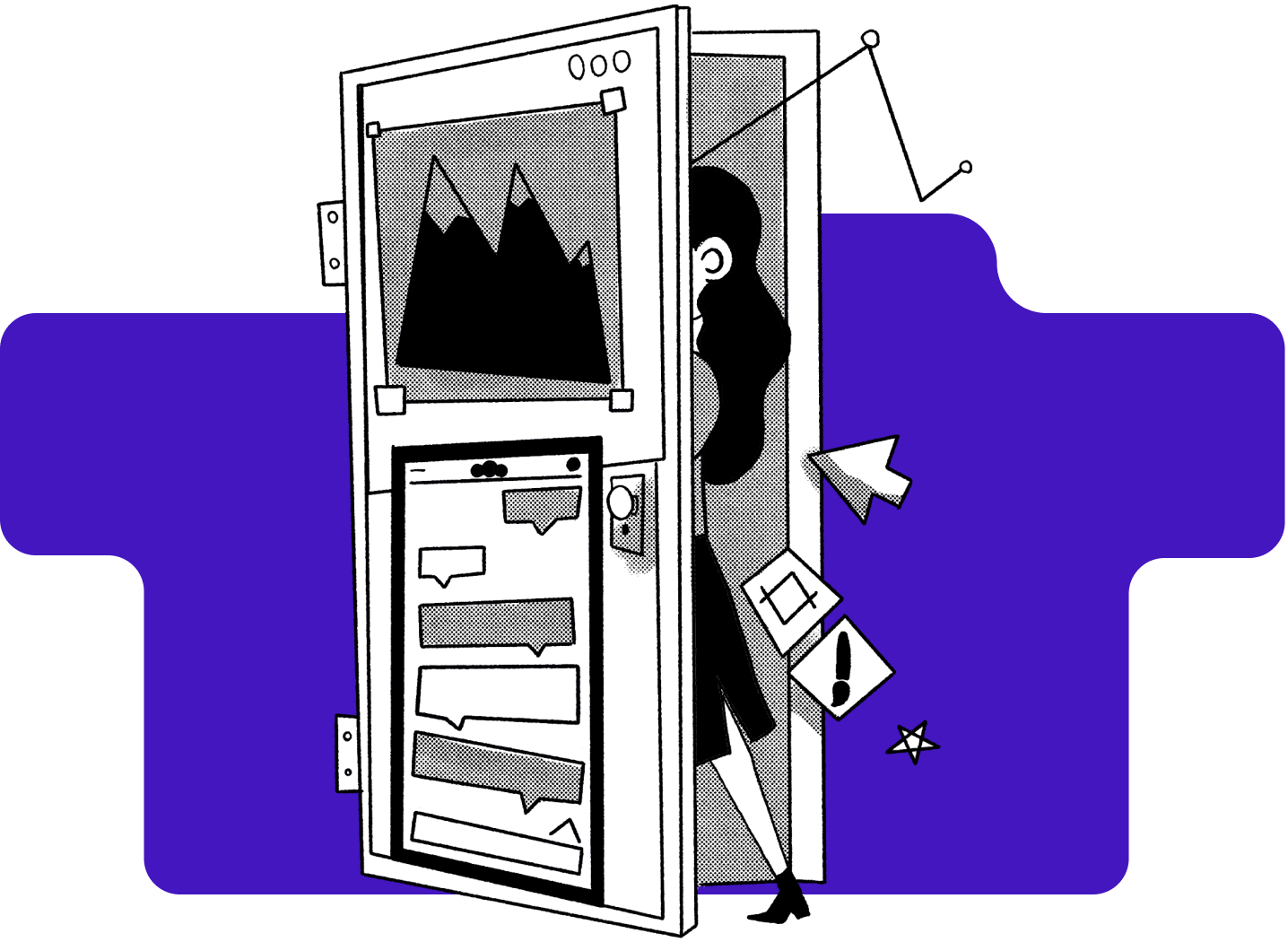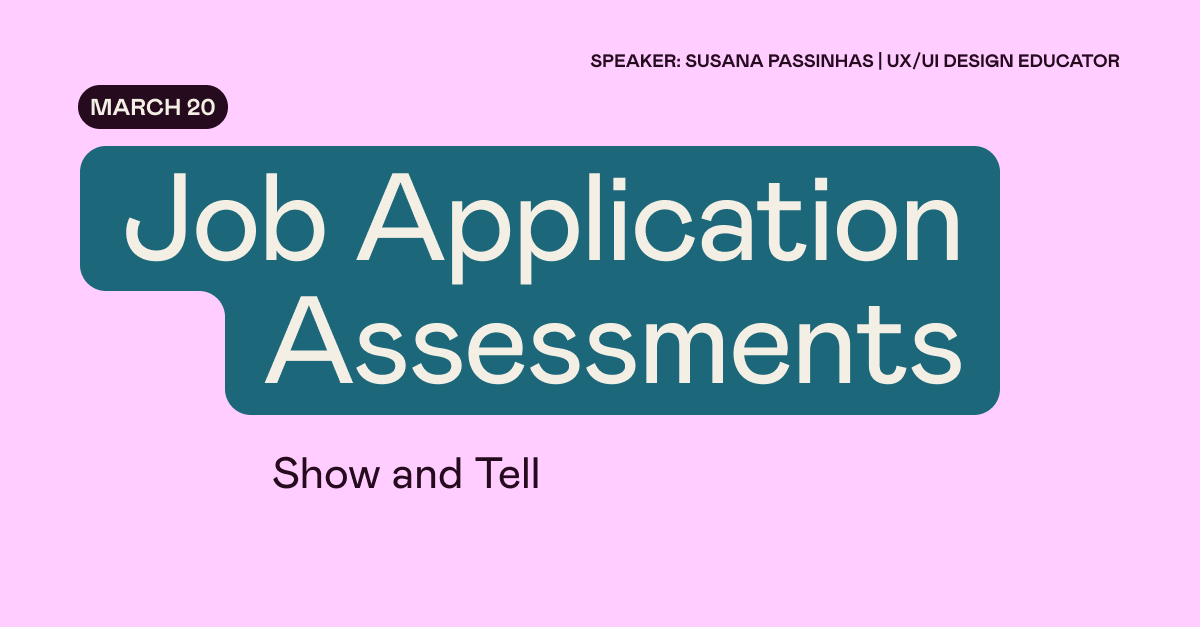In our very first Industry Voices webinar and interview you’ll learn from Kelly Stevens, a product designer with 8+ years of experience designing digital products and systems at scale. Kelly is currently a senior product designer at WeTransfer in Amsterdam, where she designs tools to move ideas, and she was previously part of the design teams at Facebook Messenger and Tripadvisor.
Your portfolio is your very own little corner of the internet and, in our competitive UX/UI design industry, it’s crucial to make the most of this space. In this webinar and interview, Kelly shares her top tips for crafting an effective design portfolio.
In the webinar you’ll hear 7 design portfolio tips, including:
- Design for the job you want
- Start with the story
- Find inspiration from others you admire
- Sweat the details
- Update often (enough)
- Share it everywhere
- Always. Save. Your Files.
After the live webinar, we caught up with Kelly to get her answers to questions that were asked during the Q&A that we didn’t get to during the live event.
Read on to hear Kelly’s answers to some important questions about portfolios and the job search, as well as to learn more about Kelly’s background as a product designer.
Hey Kelly! Thanks for chatting with our community. We’d love to know a little more about your background. You studied Graphic Design at Syracuse, how did you then grow into becoming a product designer? Did you have any formal education or are you self-taught?
I don't think I qualify as self-taught. I was lucky enough to spend three years studying graphic design at Syracuse, learning foundational skills like typography, hierarchy, layout, and color theory, which are all applicable to the work I do as a digital product designer.
There weren't any courses in my program on interaction design, though. I got a first taste of that during a summer internship at Tripadvisor. I didn't know what I would be working on when I started there, so for the first month I helped out with miscellaneous projects. But then a wonderful team of people invited me to shadow them while they built a new iPad app. They even let me design a couple of features (with help from a fantastic mentor). When the app was released on the App Store a few months later, it felt so cool to have been part of making something that millions of people could download and use. I've been practicing digital product design ever since.
It’s so great that an internship at Tripadvisor eventually became a full-time role. Can you share more about your time at Tripadvisor?
Of course, I love talking about Tripadvisor! I feel so lucky to have worked there for my first full-time job. My coworkers were so generous with their knowledge and so open to sharing opportunities. Even though I was a junior-level designer with relatively little experience, I was still given the flexibility to switch teams occasionally and work on a variety of projects with people all across the company. I started on the Restaurants team (designing an interface to book reservations), moved to the Hotels team (designing the checkout flow to pay for bookings), and then joined the Mobile Experience team (designing an Apple TV app based on iOS).
If you're just starting out in design and have the opportunity to join a company that offers you this much flexibility, I would highly recommend it. Experimenting with different projects, teams, and work styles can help you learn about yourself as a designer and the types of work you most enjoy.
Sounds like a great first role. We learned in the webinar that after Tripadvisor you started working at Facebook, and during your time at FB you also did some interviewing. What did you learn about how recruiters review portfolios from your time interviewing candidates at Facebook?
Recruiters at big companies like Facebook review loads of portfolios. Assume that they only have 30 seconds to spend on yours. Don't bury your work behind too many clicks or transitions. Put it right in front of them!
That’s great advice. And that brings us to where you are today, can you tell us about your current role as a product designer at WeTransfer? What are your day-to-day activities?
Product designers at WeTransfer work closely with development teams on a two-week sprint cadence, so the structure of our day-to-day comes from stand-ups and other recurring sprint meetings. In between those, I spend the rest of my time designing, but the work itself really varies depending on the phase of a project.
On any given day, I might be:
- Collaborating with product managers and engineers to shape a new initiative
- Wireframing high-level concepts
- Building prototypes for UX research
- Experimenting with different interactions for a feature
- Writing user stories
- Recording a Loom video to send to other designers for feedback
- Discussing work in Design Crit or in a refinement with engineers
- Testing a development build
- Making updates to our design system
That’s an exciting range of responsibilities! Do you have any tips on how to best use social media (Twitter, Instagram, etc.) to showcase your work?
Add a link to your portfolio in the bio of every social account you plan to use professionally.
Focus on making your LinkedIn profile current and complete, including:
- Writing a brief bio in the about section
- Adding skills
- Asking for recommendations from your mentors
- Uploading media snapshots of your best designs
- Building your network by connecting with people you know
After that, decide how much energy you want to invest in other forms of social media, and let that guide you. There is no need to try and use every platform to promote your work—that would be exhausting. But if you already spend time on Twitter, Instagram, or another app, go for it!
Great tips! In the webinar you mentioned that people can tell if you use a Squarespace template, but also that you don't need to necessarily code it yourself. How do you use a template without it actually looking like a template?
A good website template should offer plenty of flexibility and options for customizing typography, color, and spacing. Experiment with each of those settings and make the template your own! There's nothing wrong with using a template, but it's important to add your own flavor to it and design beyond the default settings.
Do you suggest any specific software for portfolio creation (Squarespace, Webflow, etc.)?
Like I mentioned in the webinar, Squarespace was my go-to site builder for more than six years. It was reliable, stable, and required absolutely no maintenance. I built my current site on Webflow, though, because it let me start from scratch without working from a template. Webflow is a really powerful tool if you can put in a bit more time to learn how it works. I have also heard great things about Readymag. Lots of these tools have similar features, so it comes down to your preference!
Totally agree. How would you recommend career switchers highlight their background before UX/UI design on their portfolio? Especially for those coming from previous design fields (like graphic design, architect, fashion, etc.)
Most designers add a section in their portfolios with a brief biography. If you have a background in another discipline, definitely mention it there. If you're still practicing and creating work in a discipline like graphic design, architecture, or fashion design, consider adding a page in your portfolio to showcase some of that work. To recruiters, expertise in another field (even if it doesn’t feel directly “design” related) signals that you are a more well-rounded candidate who can apply different approaches to solving design problems. Anyway, design is such a multidisciplinary field that almost anything can shape your practice.
We agree that preference is what it really comes down to. Last question, for someone creating their first design portfolio, what are your top 3 things to keep in mind?
1. The work itself will speak loudest
Even though I gave lots of tips in the webinar talking about how to design a portfolio around your content (selecting templates, ensuring responsiveness, etc.), it's important to put most of your energy into the material itself. Curate your very best designs and shape them into case studies with clear narratives. It won't matter what the rest of your portfolio looks like if the content isn't there. It would be like eating a sandwich without anything in it!
2. Hold yourself to reasonable expectations
Designers are constantly improving their craft through experience and practice. If you're a new designer creating your first portfolio, don't worry if you never feel completely satisfied with it. This is how designers feel all the time.
3. Update often
Your "first" portfolio shouldn't live long. As you improve your craft and produce even better work, make sure that you iterate on your portfolio to reflect your growth as a designer. The beauty of a digital portfolio is that it's super easy and inexpensive to change.
Explore Kelly's portfolio and connect with her on LinkedIn.
If you’re interested in putting Kelly’s advice into practice and creating your very own UX design portfolio, we encourage you to check out our UX Academy bootcamp.



.svg)







%20(1)-min.png)






